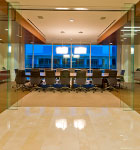At a Glance
Location
Germantown, WI
Founded
1964
Employees
50
Specialties
Full-service concrete-floor polishing, coating, installation, and restoration
The construction of a four-story, 115,000-square-foot research and teaching facility will almost always win its builders an attentive audience. And when the high-profile project in question is Marquette University’s brand-new College of Engineering—intended to inspire and educate the next generation of building professionals—that attentive audience will also be a lasting one. D&B Industrial Floor Coatings, Inc., which won the bid for the facility’s flooring system, kept this attention in mind when designing and installing more than 40,000 square feet of polished and dyed concrete.
For the project, D&B treated its densified concrete slabs with a final stain protectant that resists daily splash and spill and eliminates the need for waxing, and extensive polishing and dyeing gave the concrete an aesthetic appearance in keeping with the College of Engineering’s design. “[It’s] a slightly daunting undertaking,” D&B president and owner Brad Van Dam says of the Marquette University project, “knowing your work will daily be viewed by up-and-comers in your industry, engineers with an eye for detail, and the people who teach them. It was a challenge we enjoyed taking on.” It was thanks to its growing presence and knowledgable staff that D&B won the bid for the academic facility, and the firm’s emphasis on sustainability took the project—and is taking D&B itself—to the next level.
Top 5 Steps of a Concrete Floor Polishing
1. Evaluate the floor conditions of a new or existing facility thoroughly.
2. Listen to and understand the client’s expectations for the floor’s lifecycle.
3. Present a thorough proposal with descriptions of the work involved and on-site samples. This will help set the client’s expectations.
4. Prepare thoroughly with prepour planning, preinstallation conferences, and protection of the concrete prior to installation of the polished system. It’s also best to develop a comprehensive floor-protection plan, a maintenance procedure, and a protection schedule.
5. Install polished slab to match the specifications.
D&B got its start in the mid-1950s as a division of Wilm Janitorial, founded by Bernard Wilm. In 1964 the flooring division was incorporated as a separate business, and Wilm’s son Dennis nurtured its growth. Today, Van Dam, Dennis Wilm’s nephew, sustains the family tradition, and projects now range from small restorations to million-square-foot corporate distribution centers.
A strong presence in the retail and commercial sector accounts for approximately 60 percent of D&B’s revenues, largely because of the firm’s arrangements with big-name companies. In 2004 and 2005, the business won a contract with Home Depot to seal and polish the floors of the company’s Midwest and Southern retail outlets, and the success of that relationship spurred the company to establish similar contacts. “We began working with other retailers on the top 10 list,” Van Dam says, “to prevent one client from accounting for too much of our annual volume.”
With more than 50 full-time employees, continuing education is one of D&B’s highest priorities. The company trains its field staff on updated, innovative techniques and procedures through in-house and on-site instruction. Staff members attend monthly Saturday sessions with major vendors and suppliers, and foremen are OSHA-certified in safety and health hazards. “We’re committed to cross-training our staff so we can respond quickly to client demands,” Van Dam says, “and so [the staff is] equipped to handle all different systems in short installation windows.”
That set of systems increasingly includes green building practices, so D&B targets low- to zero-VOC floor treatments whenever possible; the company’s goal is to eventually eliminate solvent-based coatings entirely. Because of this, each product used in the Marquette project contributed LEED points, from the final stain protectant to the recycled and reclaimed diamond pads used in the polishing process.
Van Dam says his firm’s greatest challenge is managing customer expectations. Commercial carpets may require replacement in three to seven years, but clients know exactly how it will look the day they install it. With polished concrete floors, clients commit to variations and a more subjective system. “But,” Van Dam says, “you also get lower maintenance costs, potentially a longer life, and a more unique look with character.” ABQ


